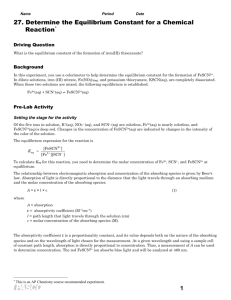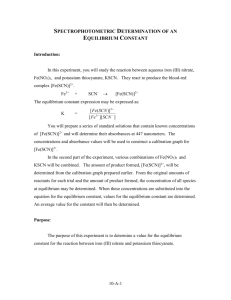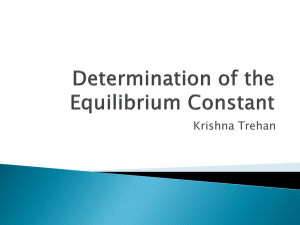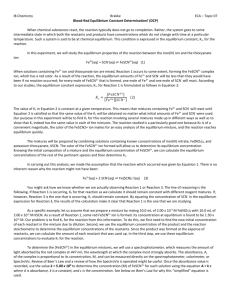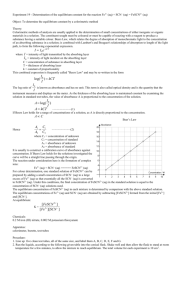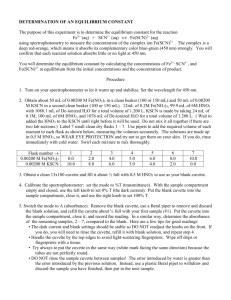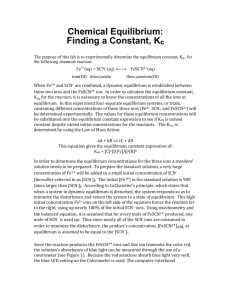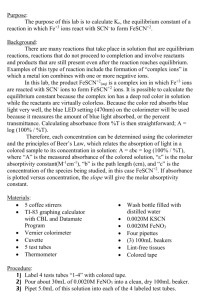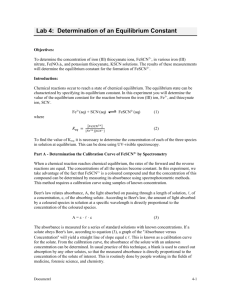Spectrophotometric Determination of an Equilibrium Constant
advertisement
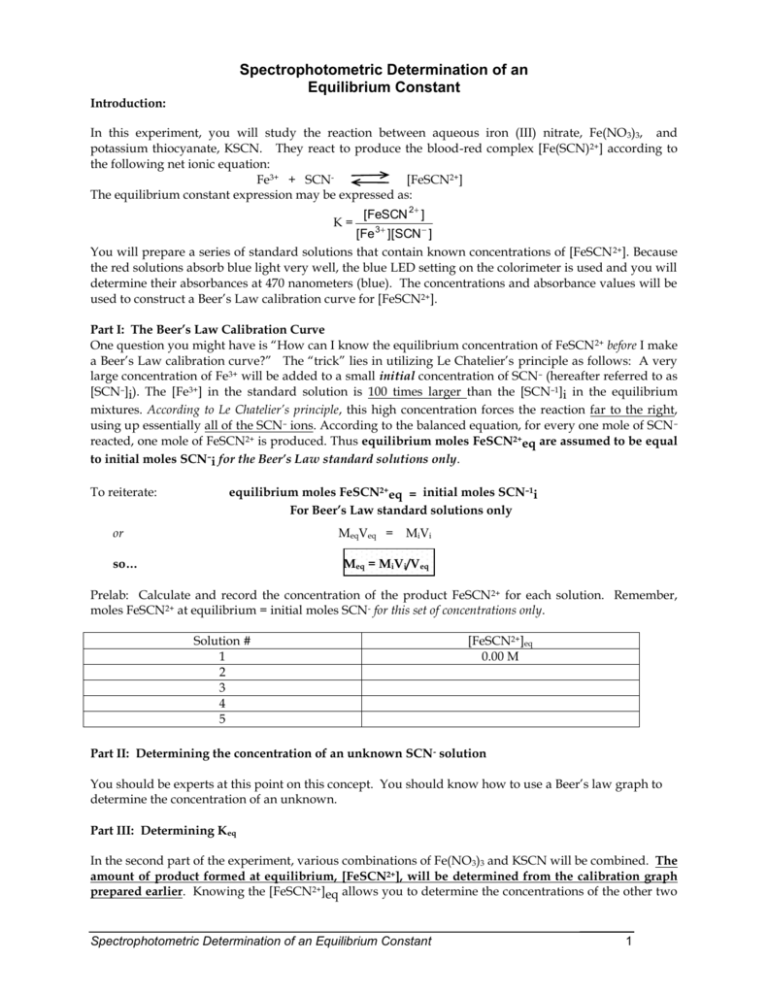
Spectrophotometric Determination of an Equilibrium Constant Introduction: In this experiment, you will study the reaction between aqueous iron (III) nitrate, Fe(NO 3)3, and potassium thiocyanate, KSCN. They react to produce the blood-red complex [Fe(SCN)2+] according to the following net ionic equation: Fe3+ + SCN[FeSCN2+] The equilibrium constant expression may be expressed as: K= [FeSCN 2 ] [Fe 3 ][SCN ] You will prepare a series of standard solutions that contain known concentrations of [FeSCN 2+]. Because the red solutions absorb blue light very well, the blue LED setting on the colorimeter is used and you will determine their absorbances at 470 nanometers (blue). The concentrations and absorbance values will be used to construct a Beer’s Law calibration curve for [FeSCN2+]. Part I: The Beer’s Law Calibration Curve One question you might have is “How can I know the equilibrium concentration of FeSCN 2+ before I make a Beer’s Law calibration curve?” The “trick” lies in utilizing Le Chatelier’s principle as follows: A very large concentration of Fe3+ will be added to a small initial concentration of SCN– (hereafter referred to as [SCN–]i). The [Fe3+] in the standard solution is 100 times larger than the [SCN–1]i in the equilibrium mixtures. According to Le Chatelier’s principle, this high concentration forces the reaction far to the right, using up essentially all of the SCN– ions. According to the balanced equation, for every one mole of SCN – reacted, one mole of FeSCN2+ is produced. Thus equilibrium moles FeSCN2+eq are assumed to be equal to initial moles SCN–i for the Beer’s Law standard solutions only. To reiterate: equilibrium moles FeSCN2+eq = initial moles SCN–1i For Beer’s Law standard solutions only or MeqVeq = so… Mi V i Meq = MiVi/Veq Prelab: Calculate and record the concentration of the product FeSCN 2+ for each solution. Remember, moles FeSCN2+ at equilibrium = initial moles SCN- for this set of concentrations only. Solution # 1 2 3 4 5 [FeSCN2+]eq 0.00 M Part II: Determining the concentration of an unknown SCN - solution You should be experts at this point on this concept. You should know how to use a Beer’s law graph to determine the concentration of an unknown. Part III: Determining Keq In the second part of the experiment, various combinations of Fe(NO 3)3 and KSCN will be combined. The amount of product formed at equilibrium, [FeSCN2+], will be determined from the calibration graph prepared earlier. Knowing the [FeSCN2+]eq allows you to determine the concentrations of the other two Spectrophotometric Determination of an Equilibrium Constant 1 ions at equilibrium. For each mole of FeSCN 2+ ions produced, one less mole of Fe 3+ ions will be found in the solution (see the 1:1 ratio of coefficients in the balanced chemical equation). The [Fe3+]eq can be determined by: [Fe3+]eq = [Fe3+]i – [FeSCN2+]eq In words: The equilibrium concentration of Fe3+ is the initial concentration of Fe3+ (after dilution) minus the amount that reacted to form FeSCN2+ (determined by spectroscopy). The [FeSCN2+]eq is determined by using spectroscopy and the Beer’s Law calibration curve. Because one mole of SCN- is used up for each mole of FeSCN2+ ions produced, [SCN-]eq can be determined by: [SCN–1]eq = [SCN–1]i – [FeSCN2+]eq Knowing the values of [Fe3+]eq, [SCN–1]eq, and [FeSCN2+]eq, you can then calculate the value of Kc, the equilibrium constant. When these concentrations are substituted into the equation for the equilibrium constant, numerical values for the equilibrium constant are determined. An average value for the constant will then be determined. Objectives: In this experiment, you will Prepare and test standard solutions of FeSCN2+ in equilibrium. Find the concentration of an unknown SCN- solution. Determine the molar concentrations of the ions present in an equilibrium system. Determine the value of the equilibrium constant, K, for the reaction. MATERIALS computer Vernier computer interface Logger Pro Vernier Colorimeter 1 plastic cuvette five test tubes Test tube rack thermometer Plastic Beral pipets (11) 0.0020 M KSCN 0.0020 M Fe(NO3)3 (in 1.0 M HNO3) 0.200 M Fe(NO3)3 (in 1.0 M HNO3) Unknown SCN- solution 3 10-mL pipets Pipet bulb 5 50-mL volumetric flasks Kim wipes (preferably lint-free) Safety and Disposal Guidelines: Goggles (and apron) should always be worn in the lab. The Fe(NO3)3 solutions are dissolved in 1.0 M HNO3, a strong acid. 0.050 M HNO3 is used as well. In case of eye contact, flush with water for 15 minutes in an eye-wash. In case of skin contact, flush with water for 15 minutes. Dispose of all solutions in the waste bottle in the hood. Do not flush solutions down the drain. Spectrophotometric Determination of an Equilibrium Constant 2 Procedure: PART I: BEER’S LAW CALIBRATION CURVE 1. Connect a colorimeter to Channel 1 of the Vernier computer interface. Connect the interface to the computer. Start the Logger Pro program on your computer. Open file “10 Equilbrium” from the Advanced Chemistry with Vernier folder. 2. Set the wavelength on the colorimeter to 470 nm. Prepare a blank by filling an empty cuvette ¾ full of distilled water. Place the blank in the colorimeter, close the lid, and press the CAL button. 3. Clean, dry, and label 4 small beakers to contain the necessary reagent solutions (0.0020 M KSCN, 0.0020 M Fe(NO3)3, 0.200 M Fe(NO3)3, and dH2O). 4. Obtain the necessary reagents and dispense about 30 mL of each into a small beaker. 5. Prepare the five solutions according to the chart below. Use 10 mL pipets to transfer each solution to a 50 mL volumetric flask. Mix each solution thoroughly. Measure and record the temperature of one of the above solutions to use as the temperature for the equilibrium constant. Standard Solutions: Volume Volume 0.200 M Fe(NO3)3 (mL) 0.0020 M KSCN (mL ) 1 5.0 0.0 2 5.0 2.0 3 5.0 3.0 4 5.0 4.0 5 5.0 5.0 To correctly use a Colorimeter cuvette, remember: Solution Volume distilled water (mL) Fill to the line Fill to the line Fill to the line Fill to the line Fill to the line All cuvettes should be wiped clean and dry on the outside with a tissue. Handle cuvettes only by the top edge of the ribbed sides. All solutions should be free of bubbles. Always position the cuvette with its reference mark facing toward the white reference mark at the top of the cuvette slot on the Colorimeter. 6. You are now ready to collect absorbance data for the Beer’s Law standard solutions. a. Click to begin data collection. b. Empty the water from the cuvette. Rinse it twice with ~1 mL portions of solution 1. c. Wipe the outside of the cuvette with a tissue and then place the cuvette in the Colorimeter. After closing the lid, wait for the absorbance value displayed in the meter to stabilize. Then click , type the FeSCN2+ concentration in edit box, and press the ENTER key. d. Discard the cuvette contents as directed by your teacher. Rinse the cuvette twice with the second solution and fill the cuvette 3/4 full. Follow the Step-c procedure to find the absorbance of this solution. Type the FeSCN2+ concentration in the edit box and press ENTER. e. Repeat the Step-d procedure to find the absorbance of the remaining standard solutions. f. Record the concentration and absorbance values in the data table. g. Determine the best fit line by clicking the Linear Fit button, . h. Record the equation of the line and print a copy of the graph. Spectrophotometric Determination of an Equilibrium Constant 3 i. Dispose of all solutions as directed by your instructor. PART II: TEST AN UNKNOWN SOLUTION OF SCN7. Use a pipet to measure out 5.0 mL of the unknown into a clean 50-mL volumetric flask. Add precisely 5.0 mL of 0.200 M Fe(NO3)3 and fill to the line with distilled water. Mix thoroughly. 8. Rinse the cuvette twice with ~1 mL amounts of the resulting solution and then fill it ¾ full. Clean the cuvette and place it in the colorimeter. Watch the absorbance readings in the Meter window. Once of the reading stabilizes, record the absorbance value of the unknown in your data table. Remove and clean the cuvette. 9. Determine the concentration of the unknown SCN- solution. With the linear-regression curve still displayed, choose Interpolate from the Analyze menu. Move the cursor until the absorbance is approximately the same as you obtained in step 8. Record this value in your data table. PART III: DETERMINATION OF EQUILIBRIUM CONSTANT 10. Clean and dry 5 large test tubes and label them 1-5. Use a pipet to measure the target volumes of the reactants listed below. Note that this set of combinations uses the more dilute Fe(NO 3)3 solution. Trial 1 2 3 4 5 Volume 0.0020 M Fe(NO3)3 (mL) 3.00 3.00 3.00 3.00 3.00 Volume 0.0020 M SCN- (mL) 0.00 2.00 3.00 4.00 5.00 Volume distilled water (mL) 7.00 5.00 4.00 3.00 2.00 11. Measure the absorbance of each equilibrium solution following the same steps as in Part I. NOTE: You are not making a graph this time. Simply record the absorbance values in your data table for further analysis. 12. To get good data for the calculation of Keq, you must determine the net absorbance of the solutions in test tubes 2-5. To do this, subtract the absorbance reading from test tube 1 from the absorbance readings of test tubes 2-5, and record these values as net absorbance in your data table. Spectrophotometric Determination of an Equilibrium Constant 4 Data Table 1. Parts I and II: Beer’s Law Data Solution 1 Absorbance 2 3 4 5 Unknown, Part II Best-fit line equation for Part I standard solutions: ______________________________ Temperature: ________________________ Concentration of Unknown: _______________________________ Table 2. Part III: Absorbance Data Test tube number 1 Absorbance Net Absorbance 2 3 4 5 Calculations Part III: 1. Determine the initial concentrations of SCN- and Fe3+ in the test tubes. Give an example of your calculations and place the rest of your values in the table below. Table 3. Initial Concentrations of SCN- and Fe3+ Test tube # 2 3 [SCN-]i 4 5 [Fe3+]i 2. Use the net absorbance values in Part III (these go in as y) and the best fit line equation in Part I to determine the [FeSCN2+] at equilibrium. Give an example of your calculations and place the rest of the values in the table below. Table 4. Equilibrium concentration of FeSCN2+ Test tube # 2 3 [FeSCN2+]eq Spectrophotometric Determination of an Equilibrium Constant 4 5 5 3. Calculate the equilibrium concentrations for Fe3+ and SCN- for the mixtures in test tubes 2-5. This is done by using the equation: [Fe3+]eq = [Fe3+]i –[FeSCN2+]eq. Give an example of your calculations and place the rest of the values in the table below. Table 5. Equilibrium concentrations of SCN- and Fe3+ Test tube # 2 3 [SCN-]eq 4 5 [Fe3+]eq 4. Calculate the value of Keq for test tubes 2-5. Give an example of your calculations and place the rest of the values in the table below. Table 6. Keq Test tube # Keq 2 3 4 5 Lab Report Consider the following points when creating your report; they are the basis for which your grade will be assigned: Theory: describe and explain Beer’s Law, show equations, discuss equations used. Describe a Beer’s law curve, discuss what it is used for and why they are useful, describe and discuss chemical equilibrium. What does equilibrium mean for a chemical reaction, what is the equilibrium constant (include an equation) describe how the equilibrium constant can be calculated. Procedure: reference the lab handout then BRIEFLY (1-2 paragraphs) give a short written explanation (sentence format – not bulleted!) of what was done in lab. Data: You may use the worksheet pages directly here. If you need a clean copy, please go to Mrs. Weston’s website. You will need to pay attention to significant figures in your data and calculations. Calculations: You may use the worksheet pages directly here. Again, clean copies are on the website. Graphs: Include a copy of the Beer’s Law Graph. Error Analysis: What should be true about all of the values of Keq? Comment on your level of precision and accuracy. What sources of error might there have been? Conclusion: This is really one of the most important parts. Your conclusion should include a summary statement of your results, as well as a few statements expressing what you learned from completing this experiment and how it relates to your course studies. Spectrophotometric Determination of an Equilibrium Constant 6
